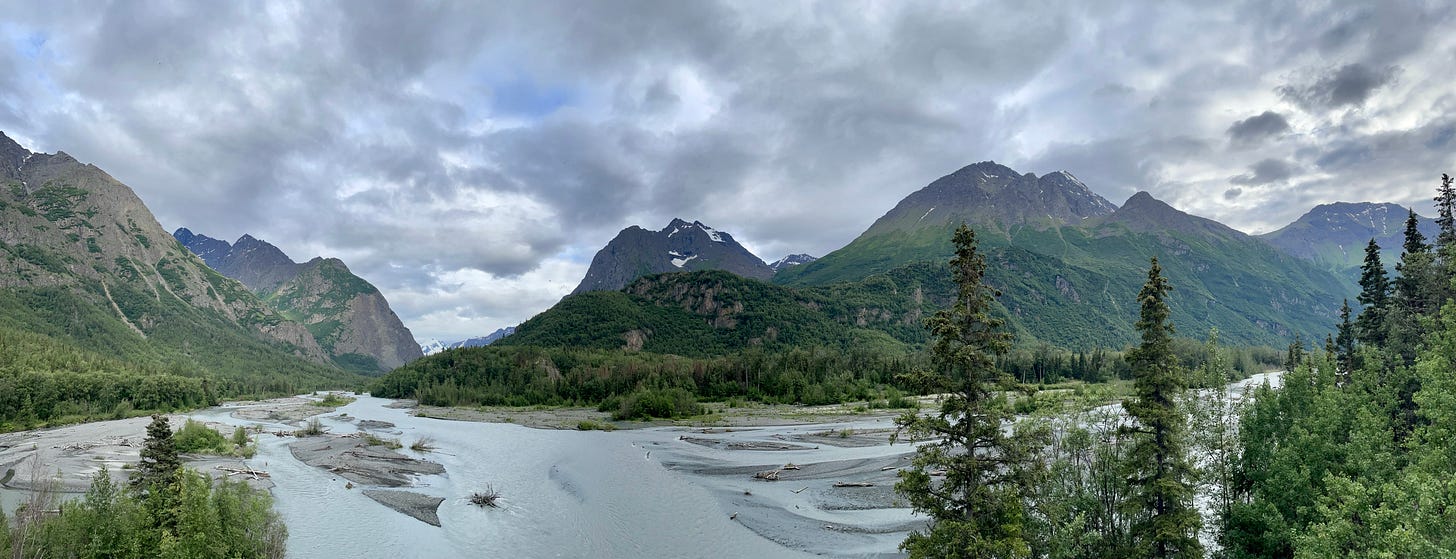Some Reflections on Backpacking
Travel Speeds, Waterways, and Boulder Fields
I trekked into the Alaskan wilderness recently to support a mountain marathon my brother was running in, and while out there I remarked that it’d be a good opportunity to check the math on travel times. We had moderate packs, about 40 lbs (4 st) each, leaving us “unencumbered” (though we certainly would’ve questioned the applicability of that word), for an expected speed of 24 miles per day. The hilly, forested terrain each imposed a x2/3 movement modifier, but with a trail negating one of those penalties, for a net x2/3 and an expected 16 miles travelled per day. How does that match up?
The first night, we got off work and drove out, spending only a half day of hiking (about 4 hours including time to set up camp), and made it in 8 miles — exactly what would be predicted. The next day we forced a march for x1.5 movement (and we definitely needed a rest day afterwards), and made it a little over 23 miles, again almost exactly what would be predicted. So the numbers seem pretty good.
If I had to quibble with the travel math, it’d be that we don’t have the endurance of hardy adventurers to do 16 miles per day every day for a week through that rough terrain. On the reverse side, I think it would definitely have been easier with lighter packs (among other things, we hauled 10 lbs of apple sauce packets in to reenergize the runners), and I think a movement speed increase could probably have been justified for a party that was truly unencumbered (i.e. carrying nothing at all, except perhaps an adventuring harness). That is after all what the runners did and they moved a little faster than the rules would suggest. Most finished in 3 to 5 hours; call it a half day forced march for characters with Running, and they’d only be expected to traverse 15 miles and need another x1.5 modifier to make it.
Another point interesting to note is the frequency of water features. I’ve said before that you can hardly have too many rivers and streams on a hex map. We traveled through some three 6-mile hexes (in, and then out), and in the process traversed two waist-high or higher rivers (one with a bridge, thankfully), a couple of smaller bridges over smaller creeks, four creeks we had to ford (ranging from ankle deep to upper thigh), and a fair few patches of swamp (two with boards laid over them). It doesn’t seem an exaggeration to say that every single 1.5-mile hex we traversed contained some sort of water feature.
Difficulty in securing a water source thus seems likely to develop from either those uncommon regions that don’t have abundant surface water (not quite so rare as the above suggests, when you consider that we were travelling along a river), or from unsafe water sources (of which there were many).

The weather was quite hot (upper 70s — very hot for Alaska, and Anchorage feels hotter than it is in summer), with the notable consequence that later in the day the water levels were higher (because they’re driven by glacial melt, exacerbated by heat). Last year it had been horribly rainy, which also drove water levels up (they actually had to postpone the race when the river became unfordable), so in that regard it’s a lose-lose proposition at both extremes.
Another item of interest to note was the presence of alluvial fans, great boulder fields of rock and sediment left by glaciers and shifting rivers. None were large enough to fill a 6-mile hex, so it’d be a stretch to call them a major terrain piece, but there were certainly some that dominated 1.5-mile hexes and could provide an interesting pit of local texture to some regions. I’ve seen similar boulder fields shaped like craters up on the moors further north when hunting caribou, though generally smaller in those cases. Grander rivers and proper glaciers could perhaps leave yet larger fields, or perhaps the rubbled remnants of titanic deeds. Whatever their source, boulder fields seem an underused hexcrawl terrain.
Overall, it was a good couple of days, I enjoyed it, certainly more than the pouring rain and perpetual wetness of last year. And ACKS seems to have predicted our travel pretty well, as I expected it to.




You went out into the real world and actually did wilderness travel to test the ACKS wilderness travel rules? You, sir, are an Olympian of RPGs!